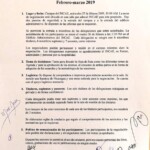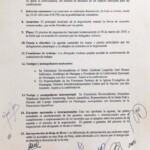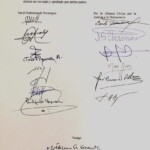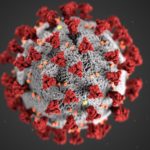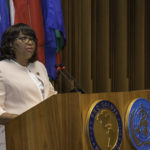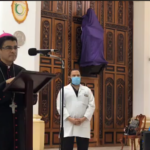OrMu and Alianza Finally Agree on Roadmap.
A computer, a printer, a flag, and a round table. These four items are listed in the OrMu-Alianza “Roadmap for Negotiations,” finally made public on Tuesday, after five days of meetings that seemed hopelessly stalled. Unfortunately, the much anticipated document was a disappointment for many, as it did not include a clear agenda or name international guarantors.
In other words, the sixteen-point document did not settle the most important questions, though it did shed light on procedure and logistics. We now know that there will be a Nicaraguan flag in the conference room, and that during debates, each principal negotiator will address his colleagues for 3 minutes, as everyone sits at a round table, in a room, equipped with a computer and a printer. Every Monday through Friday, starting at 10 A.M, they will come to this room, but they won’t disclose anything that hasn’t been approved by consensus. Furthermore, the press will only be allowed at the venue when summoned, and even then, journalists will have a designated spot.
But it was not all minutiae. No. The roadmap also included important insights into the dynamics of these negotiations. For one, the roadmap dismisses what the Alianza communicated through leaks to the press. For example, anonymous sources, most likely linked to the Alianza or the Catholic Church, disclosed OrMu’s objections against having having the Catholic Church as a mediator to journalist Luis Galeano. Now we know that OrMu prevailed on this issue. In fact, the word “mediator” does not appear in the roadmap document at all. Instead, terms like “witnesses and companions” are preferred.
The witness role seems defined in point 15 of the document, “interpretation of the roadmap”:
The differences in interpretation that may arise about what is agreed upon on this roadmap will be settled internally by the witness that accompanied the discussion of the same.
There was only one witness to the discussion of the roadmap, Mons. Waldemar Sommertag, the Apostolic Nuncio. In other words, he is the only one authorized to settle disputes, albeit only those regarding the “interpretation of the roadmap.”
Mons. Sommertag will continue on as a the “international witness and companion,” as established in item 13 of the document.
As for the other witnesses, it will be Cardinal Brenes, for the Catholic Church, and a “representative of the Brother Pastors of the Evangelical Churches of Nicaragua”. Presumably, that person will be Pastor Jorge Ulises Rivera. Each witness will have two advisors.
🚨 Se redactaron tres cartas: 1. Al Nuncio Apostólico, 2. @CENicaragua y 3. Al pastor Ulises Rivera para estar presentes en el Diálogo Nacional. #DiálogoNi
— Confidencial.com.ni (@confidencial_ni) March 6, 2019
According to an anonymous source, the Bishops will be able to select anyone in the Episcopal Conference to serve as an advisor to Cardinal Brenes, as OrMu finally relented, withdrawing the veto against Mons. Rolando Alvarez, in exchange for the inclusion of Pastor Rivera.
Me explica la fuente allegada a la negociación que la aprobación de la hoja de ruta tardó tanto porque la dictadura no quería levantar el veto de participación a Monseñor Rolando Alvarez. “Ahora el cardenal podrá llegar con quien quiera”. Ya están los 2 escogidos
— Wilfredo Miranda (@PiruloAr) March 6, 2019
That might be the only concession that OrMu made, but the inclusion of the Evangelical Church makes up for it. Many evangelical pastors have close ties to the OrMu administration. In fact, evangelical pastors have been actively participating in OrMu’s campaigns around the Peace and Reconciliation Policy, which is now the Law for a Culture of Dialogue, Reconciliation, Security, Work and Peace in Nicaragua.¹ Pastor Rivera has not been identified by name as being among them. However, he was among the guests during a the ceremony in which Daniel Ortega honored Pastor David Spencer with the Ruben Dario Order and granted him Nicaraguan citizenship.
No agenda, but tentative end date defined
Even though there is no agenda for negotiations, the roadmap establishes a tentative end date, March 28, unless the principals agree to keep going for longer.
In other words, the teams have given themselves a tentative term of 17 days — they only meet Monday through Friday — to set an agenda, discuss it, pick guarantors, and come to final agreements.
It took them five days to agree on the roadmap that turned out to be mostly about procedures and logistics. How long will it take to agree upon everything else?
Is the roadmap enough to stave off sanctions
On February 14, the president of the European Parliament sent a strong letter to OrMu, warning the administration that, unless there were substantive changes, sanctions would be coming. Soon after, the Nicaraguan dictatorial couple agreed to the negotiations with the Alianza. Now, they have made some progress. They have sat down with the opposition, agreed on a road map, and transferred at least one hundred political prisoners to house arrest.
El presidente del #PE #Tajani ya ha enviado la carta a #Ortega q le pedimos el lunes.
La semana q viene me reuniré c nuestro embajador europeo en #Managua. Si no hay cambios,en Marzo aprobaremos en el pleno una durísima resolucion contra su gobierno y pediremos sanciones severas— Ramón Jáuregui (@RJaureguiA) February 14, 2019
However, will that be enough to avoid the European Union sanctions? Jauregui indicated via Twitter that it could be. On February 15, after a meeting between OrMu and the OAS, Jauregui said that “dialogue is important and the EU must be willing to come in, if called by the parties.” Jauregui added that “the government should show a sign of political will and credibility, by liberating political prisoners or granting house arrest.”
Buena noticia la reunión gobierno/OEA #Managua
El diálogo es importante y la #UE debe estar dispuesta a incorporarse si es llamada x las partes
El gobierno debiera mostrar un gesto d voluntad política y d credibilidad liberando a los presos políticos o sustituyendo casa x cárcel— Ramón Jáuregui (@RJaureguiA) February 16, 2019
The administration has now paid lip service to “political will,” but repressive actions continue, hundreds of political prisoners are still in jail, and the dictatorship even toys with family members and others, just to be score cheap points against the independent press and the organizations that support prisoners and their families.
Take, for example, the case of Brandon Lovo and Glen Slate. On Saturday, the story about their alleged transfer to house arrest broke, when the Comité Pro Liberación de Presos Políticos announced it via social media. Four days later, the Ministry of the Interior (MiGob) held a press conference to refute the story. In a press release, MiGob accused the media of engaging in a smear campaign
“we deny the smear campaign published in print media and social media, which stated that both prisoners had disappeared.”
It took them four days to present the two men and clarify.
Cuatro días después de mantener en zozobra a las familias de Brandon Lovo y Glen Slate, Gobernación informa que están en La Modelo y niega haberlos excarcelado el sábado como confirmó el @CPLPP_Nicaragua ¿Por qué tardaron tanto en aclararlo? https://t.co/3rCIeQQ2U1 #SOSNicaragua pic.twitter.com/SGjia81yfi
— Despacho 505 (@despacho505) March 5, 2019
Now, that is what lip service to a peace process looks like. It looks like continuing denials of justice, while signing agreements about tables, office equipment, and flags.
¹For a primer on the Peace and Reconciliation Policy, refer to these posts: (1) Reconciliation Ortega Style: What we know so far about Ortega’s “Reconciliation Policy.”; (2) Orteguismo’s “Reconciliation” Proposal: A Reeducation Program for Nicaragua; (3) Updates on Ortega-Murillo’s “State Policy for a Culture of Peace and Reconciliation.”

